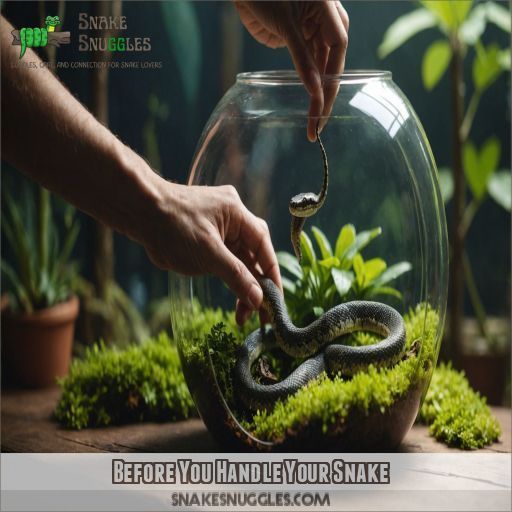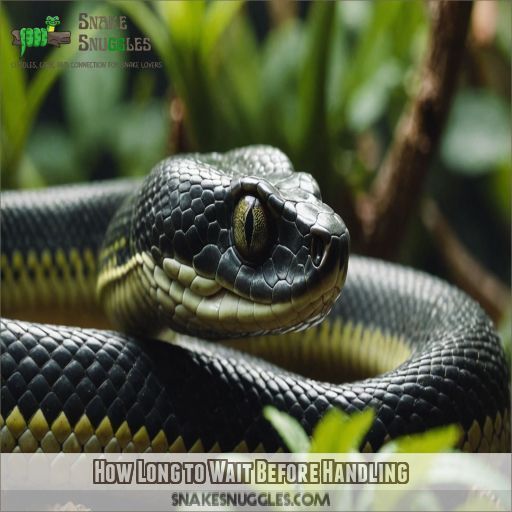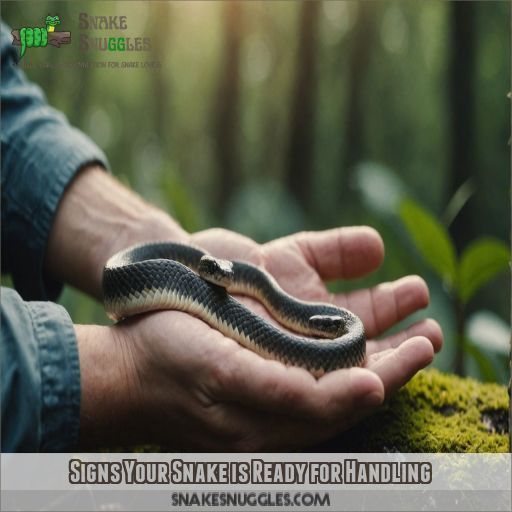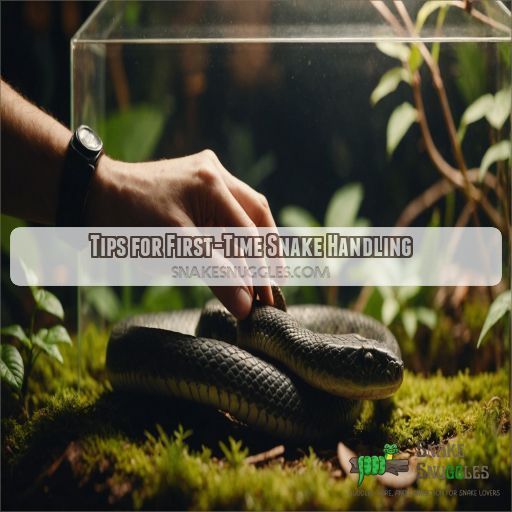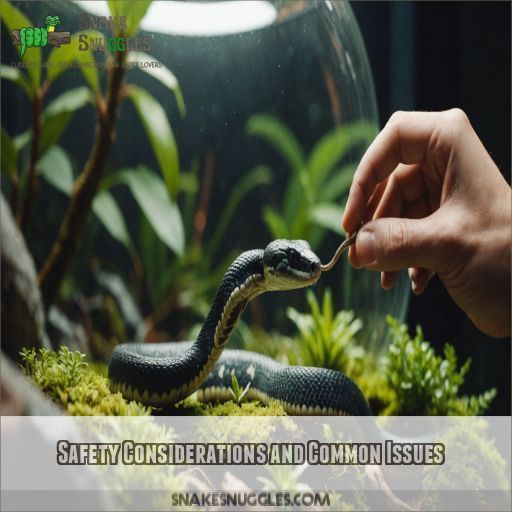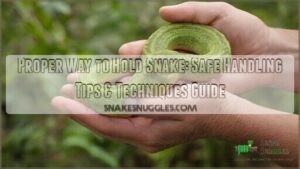This site is supported by our readers. We may earn a commission, at no cost to you, if you purchase through links.
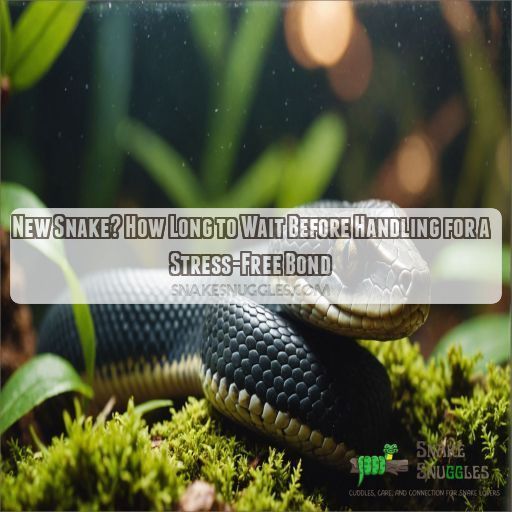 You’ve just brought home a slithery new friend and you’re itching to get hands-on!
You’ve just brought home a slithery new friend and you’re itching to get hands-on!
But before you do, it’s a good idea to give your snake some space.
The general rule of thumb is to wait 24-72 hours after bringing your snake home before handling them.
This allows your snake to acclimate to its new surroundings, get comfortable with the temperature, humidity, and hiding spots.
If your snake successfully feeds, wait another 24 hours before handling.
If not, wait a week and try again.
Giving your snake time to settle in will help make sure you have a stress-free bonding experience – and that’s just the beginning!
Table Of Contents
- Key Takeaways
- Before You Handle Your Snake
- How Long to Wait Before Handling
- Signs Your Snake is Ready for Handling
- Tips for First-Time Snake Handling
- Safety Considerations and Common Issues
- Frequently Asked Questions (FAQs)
- How long until I can handle my new snake?
- How long does it take for a snake to get used to handling?
- Can you handle a snake when you first get it?
- How long to wait to handle a new ball in python?
- What are the best snake breeds for beginner owners?
- How do I create a stress-free environment for my snake?
- What are the essential items for a snakes habitat setup?
- Can I handle my snake when its shedding its skin?
- How often should I clean my snakes enclosure and accessories?
- Conclusion
Key Takeaways
- You’ll want to give your snake some space before handling – we’re talking 24-72 hours of alone time to acclimate to its new surroundings. Think of it as a "settling in" period for your new scaly friend!
- After your snake’s first meal, wait another 24 hours before handling. This allows your snake to digest its food and reduces the risk of vomiting or stress.
- Observe your snake’s behavior and body language to determine if it’s ready for handling. Look for signs of relaxation, such as a loose coil, calm demeanor, and no rapid tongue flicking or aggressive posturing.
- When you do start handling your snake, begin with short sessions (20-30 minutes) and gradually increase the time as your snake becomes more comfortable with you. Remember to handle with care, support your snake’s entire body, and avoid grabbing its head or tail.
Before You Handle Your Snake
As you welcome your new slithery friend home, you need to give them time to settle in before handling. A stress-free bond begins with patience, so let’s explore how long to wait before handling your new snake and what you can do to create a comfortable environment for them.
Pre-Handing Preparation Tips
You’ve finally brought home your new slithery friend. Before handling, make sure you’re setting the stage for a stress-free bond with these pre-handling prep tips:
- Set up a safe environment: Create a comfortable habitat with proper temperature, humidity, and hiding spots.
- Observe behavior: Watch your snake’s behavior, appetite, and stool quality to make sure it’s healthy and relaxed.
- Wait patiently: Allow your snake to acclimate to its new surroundings for at least 24-72 hours.
Choosing the Right Snake for You
When choosing a pet snake, consider your lifestyle and home environment. Different breeds have unique care needs and personalities. Ball pythons are great for beginners, while king cobras aren’t suitable for homes with kids or pets . Research breeds thoroughly and pick one that fits your experience level and living situation for a stress-free bond (Source).
Researching Snake Breeds and Care
Now that you’ve considered your lifestyle and home environment, it’s time to research snake breeds and their care needs. Look into habitat setup costs, feeding requirements, and health checks specific to each species. Don’t be tempted by venomous snakes if you’re a beginner! Choose a breed that fits your experience level and living situation for a stress-free snake ownership experience.
Understanding Your Snake’s Habitat Needs
As you prepare for your new scaly friend, remember that a well-designed habitat is key to a happy, healthy snake. Make sure the enclosure is the right size, with a temperature range and humidity level that matches your snake’s breed. Add hiding spaces, a safe substrate, and a water dish. This will help your snake feel secure and thrive.
How Long to Wait Before Handling
You’re excited to get up close and personal with your new slithery friend, but it’s important to give your snake some space to adjust to its new surroundings before handling.
Allowing your snake to acclimate to its new environment will help reduce stress and prevent potential health issues.
Let’s explore how long you should wait before handling your new pet snake.
Giving Your Snake Time to Acclimate
Give your snake a week to acclimate to its new environment before handling. This allows it to adjust to the habitat, temperature, and humidity. Think of it as a ‘settling in’ period for your new scaly friend.
Here are some key things to do during this time:
- Observe from a distance: Watch your snake’s behavior without disturbing it.
- Ensure proper habitat setup: Double-check temperature, humidity, and lighting.
- Provide a varied diet: Offer a nutritious meal, but avoid overfeeding.
- Consult a vet: If you notice any signs of stress or illness, seek professional advice.
Factors Affecting Snake Adjustment Periods
Regarding your snake’s adjustment period, several factors come into play. Think of it like a recipe: snake temperament, environmental factors, handling techniques, snake size, and owner experience all mix together to determine how long your snake needs to acclimate.
| Factor | Impact on Adjustment Period |
|---|---|
| Snake Temperament | More docile snakes adjust faster |
| Environmental Factors | Proper habitat setup reduces stress |
| Handling Techniques | Gentle handling promotes trust |
| Snake Size | Smaller snakes adapt quicker |
| Owner Experience | Seasoned owners can shorten adjustment time |
These factors interact and influence one another, making each snake’s adjustment period unique .
Avoiding Handling Too Early
Don’t rush the romance! Handling your new snake too early can cause stress and anxiety. Give your snake at least 7-10 days to acclimate to its new environment before handling. Some breeds, like corn snakes, may need longer. Watch for signs of stress, like shedding or lethargy, and wait until your snake seems relaxed and calm.
Signs Your Snake is Ready for Handling
You’ve given your snake time to settle in, and now you’re wondering when it’s ready for handling – but how do you know? By monitoring your snake’s behavior, identifying comfortable postures, and determining the best handling timing, you can provide a stress-free and enjoyable bonding experience for both you and your new pet.
Monitoring Snake Behavior
Now that you’ve given your snake time to acclimate, it’s important to monitor its behavior to see if it’s ready for handling. You’re looking for signs that your snake is comfortable and relaxed in its new environment. Here are a few key things to watch out for:
- Changes in appetite or feeding responses
- Increased interaction with its habitat
- Absence of stress signs, such as hissing or flattening
Identifying Comfortable Snake Postures
As you observe your snake, pay attention to its body language.
A relaxed snake will have a loose, open coil with its tail gently wrapped around its body.
The head will be calm, with no rapid tongue flicking or aggressive posturing.
Eye contact is a good sign – if your snake looks at you without hissing or flattening its body, it’s getting comfortable with your presence.
Determining Optimal Handling Timing
You’ve waited patiently for your snake to acclimate – now it’s time to figure out the best time to handle it. Here are four signs to look out for:
- Relaxed posture: Your snake is stretched out, not coiled or tense.
- Active exploration: It’s curious about its environment and not hiding.
- Good appetite: Your snake is eating normally, without stress or hesitation.
- No hissing or striking: It’s calm and not defensive.
Tips for First-Time Snake Handling
As you prepare for your first snake-handling experience, it’s important to remember that a gentle and calm approach will help your new pet feel more at ease. By starting with short, stress-free interactions, you’ll set the stage for a strong bond with your snake and a lifetime of safe, enjoyable handling experiences.
Getting Started With Gentle Handling
When getting started with gentle snake handling, remember to handle your snake with care and confidence (Source). Begin by letting your snake get used to your presence, then gently touch its tail, working your way up to its head . Support its body, avoid sudden movements, and watch for signs of stress in its body language (Source).
Overcoming Common Snake Handling Fears
Now that you’ve started with gentle handling, let’s tackle those nagging fears. Are you worried about being bitten? Pay attention to your snake’s body language – if it’s tense or hissing, back off. With practice and patience, you’ll build confidence in your handling skills. Remember, safe handling techniques are key to avoiding those dreaded snake bites.
Effective Techniques for Reducing Stress
When handling your snake for the first time, create a calm and quiet space to reduce stress. Move slowly, using gentle touch, and let your snake become familiar with your scent. Avoid handling after feeding, as this can cause stress and vomiting. Start with short sessions, and gradually increase time as your snake becomes more comfortable with handling.
Safety Considerations and Common Issues
Now that you’re ready to handle your new snake, it’s important to think about the potential risks and take steps to make sure both you and your pet have a safe and stress-free experience.
From vomiting after handling to overfeeding risks, we’ll explore the common issues that may arise and provide you with expert tips on how to avoid them and keep your snake happy and healthy.
Vomiting After Handling and Overfeeding Risks
Now that you’ve started handling your snake, let’s talk about some not-so-fun stuff: vomiting.
If your snake vomits after handling, it’s likely due to stress or overfeeding.
Give it a break, make sure it has access to clean water, and soak it for an hour the next day to rehydrate.
Wait 7-10 days before feeding again, and use a smaller food item.
Avoiding Injury and Reducing Stress in Snakes
When handling your snake, safety is key. To avoid injury and reduce stress, remember:
- Read the signs: Pay attention to your snake’s body language. A tense, squirming snake is stressed.
- Handle with care: Support your snake’s entire body, and avoid grabbing the head or tail.
- Create a safe space: Make sure the enclosure is escape-proof and keeps the right heat and humidity levels.
Ensuring Snake Health and Well-being
As a snake parent, keeping your pet healthy and happy is super important. Monitor your snake’s behavior and appearance for signs of illness or distress. Consult a veterinarian if you have any concerns. Provide a suitable temperature, clean water, and a balanced diet. A happy snake is a healthy snake, so prioritize their needs for a stress-free bond.
Frequently Asked Questions (FAQs)
How long until I can handle my new snake?
Did you know that snakes can take up to 3 days to digest a small meal? When bringing your new snake home, wait at least 7-10 days before handling to allow it to adjust and reduce stress.
How long does it take for a snake to get used to handling?
You’ll want to give your snake about 7-10 days to get comfortable with its new environment before regular handling. Start with short sessions, 20-30 minutes, and gradually increase time as your snake becomes more relaxed with you.
Can you handle a snake when you first get it?
Handle with care – literally! When you first get a snake, it’s best to give it a week’s ‘VIP treatment’ – Very Important Python time – to adjust to its new surroundings before handling.
How long to wait to handle a new ball in python?
When you bring home your new ball python, wait about a week before handling them. This allows your snake to adjust to its new environment and reduces stress. Give them space, and they’ll reward you with a calm demeanor.
What are the best snake breeds for beginner owners?
As a beginner, you’ll want to start with a breed that’s as gentle as a summer breeze! Ball pythons, Corn snakes, and Gopher snakes are perfect for newbies, offering a calm and docile nature that’ll make handling a breeze.
How do I create a stress-free environment for my snake?
To create a stress-free environment for your snake, provide a calm and quiet space with a consistent temperature and humidity level. Give your snake time to adjust, and handle it gently and carefully to minimize stress.
What are the essential items for a snakes habitat setup?
Setting up your snake’s habitat? Don’t forget the essentials! You’ll need a heat lamp, water dish, hiding spaces, and a comfortable substrate. Provide a safe and cozy environment, and your slithery friend will thank you!
Can I handle my snake when its shedding its skin?
When your snake is shedding, it’s best to leave it alone. Handling can cause stress and discomfort, so wait until the shedding process is complete, usually within a few days to a week.
How often should I clean my snakes enclosure and accessories?
Cleaning the snake’s enclosure is a ‘scales‘ above the rest of your to-do list! Clean the enclosure and accessories every 7-10 days, or when you notice a buildup of waste or bacteria, to keep your slithery friend healthy and happy.
Conclusion
Don’t strike out with your slithery friend!
Now that you’ve learned the ropes, remember to give your snake space before handling.
The answer to "how long should I leave my new snake alone before I handle them" is clear: wait 24-72 hours for acclimation, and another 24 hours after feeding.
With patience and gentle care, you’ll be well on your way to a stress-free bonding experience.
Handle with care, and enjoy the hiss-terical journey ahead!

